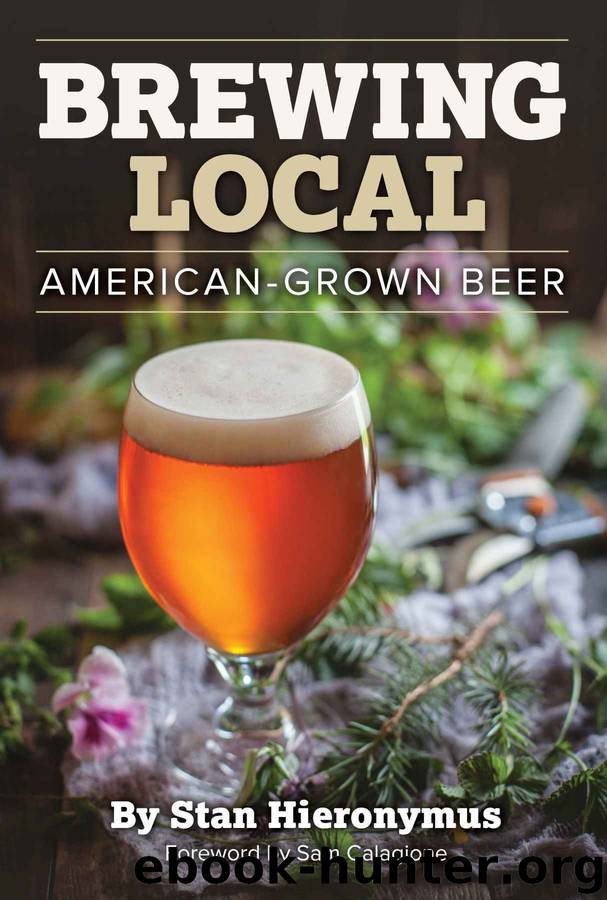Brewing Local: American-Grown Beer by Hieronymus Stan

Author:Hieronymus, Stan [Hieronymus, Stan]
Language: eng
Format: epub
ISBN: 978-1-938469-37-4
Publisher: Brewers Publications
Published: 2016-10-06T16:00:00+00:00
THE MODERNIZATION OF GRUIT
Each year on the day before Will Meyers brews Cambridge Brewing’s Heather Ale, he gathers his staff for a trip to harvest heather tips in the wild. They will brew with them the next day. Before they pick the tips, Meyers tells them about the history of heather and ale and mead, and he recites Robert Louis Stevenson’s poem, “Heather Ale.” They open bottles of the ale brewed in previous years and drink a toast. “We pour one for our friends who are no longer with us,” he said.
They will spend several hours collecting the 30 or 40 pounds of the lightweight tips needed for a batch. After stopping for a swim, they eat lobster rolls and drink beer for lunch.
“It’s the best day,” Meyers said. “It’s less about the beer and more about the ritual around it.”
Heather Ale is brewed without hops. Brewers have made beer without hops for thousands of years. Accounts of brewing in Mesopotamia and Egypt include descriptions of herbs and spices added to improve the keeping properties of beer or its flavor, and pharmacists preparing medicinal drugs often made them up in beer. These went by many names, but none of them was gruit , which was a mixture of herbs used in beer in the Middle Ages, not a type of beer.
This is mostly a matter of semantics but perhaps worth considering as more breweries make hopless beers and call them gruit . It is useful for consumers if they understand gruit means “without hops” and that other flavor and aromas, usually produced by herbs, will be prominent.
“I think a lot of people who say they don’t like bitterness just don’t like hop bitterness,” said Scratch Brewing co-founder Aaron Kleidon.
It is not necessarily what author Stephen Buhner describes in Sacred and Herbal Healing Beers : “It is highly intoxicating—narcotic, aphrodisiacal, and psychotropic when consumed in sufficient quantity. Gruit ale stimulates the mind, creates euphoria, and enhances sexual drive.”
Although many will, a modern gruit shouldn’t be required to include the ingredients most often listed as part of a gruit mixture: bog myrtle (Myrcia gale ), wild rosemary, and yarrow. In fact, bog myrtle and wild rosemary do not grow in the same regions and are similar in flavor, so they likely would not both have been part of a traditional mixture. The exact origins of the mixture are not known, but it apparently dates back to the ninth century CE. It was common in the Low Countries, the lower Rhine Valley, Scandinavia, and lower France.
Counts and bishops, depending on the continental country, controlled the sale of gruit , giving them the right to levy a tax on beer production. In addition to the mixture provided, both rural and monastic brewers often added other plant material and spices, such as ginger, anise, cumin, laurel leaves, marjoram, mint, sage, acorns, caraway, wormwood, tree bark, and seemingly almost anything else. “These were the ingredients which the fermentarius (an official in charge of gruit ) of
Download
This site does not store any files on its server. We only index and link to content provided by other sites. Please contact the content providers to delete copyright contents if any and email us, we'll remove relevant links or contents immediately.
| Beer | Cocktails & Mixed Drinks |
| Coffee & Tea | Homebrewing, Distilling & Wine Making |
| Juices & Smoothies | Wine & Spirits |
101 Whiskies to Try Before You Die by Ian Buxton(44925)
World's Best Whiskies by Dominic Roskrow(44833)
Whiskies Galore by Ian Buxton(41941)
Craft Beer for the Homebrewer by Michael Agnew(18200)
Right Here, Right Now by Georgia Beers(4170)
Not a Diet Book by James Smith(3380)
Water by Ian Miller(3158)
The Coffee Dictionary by Maxwell Colonna-Dashwood(3103)
Kitchen confidential by Anthony Bourdain(3055)
Coffee for One by KJ Fallon(2603)
Smuggler's Cove: Exotic Cocktails, Rum, and the Cult of Tiki by Martin Cate & Rebecca Cate(2499)
Superfood Smoothie Bowls: Delicious, Satisfying, Protein-Packed Blends that Boost Energy and Burn Fat by Chace Daniella(2424)
Beer is proof God loves us by Charles W. Bamforth(2420)
Talking as Fast as I Can by Lauren Graham(2412)
Bourbon: A Savor the South Cookbook by Kathleen Purvis(2270)
A Short History of Drunkenness by Forsyth Mark(2262)
Eat With Intention by Cassandra Bodzak(2177)
Cocktails for the Holidays by Editors of Imbibe magazine(2102)
Colombia Travel Guide by Lonely Planet(2095)
